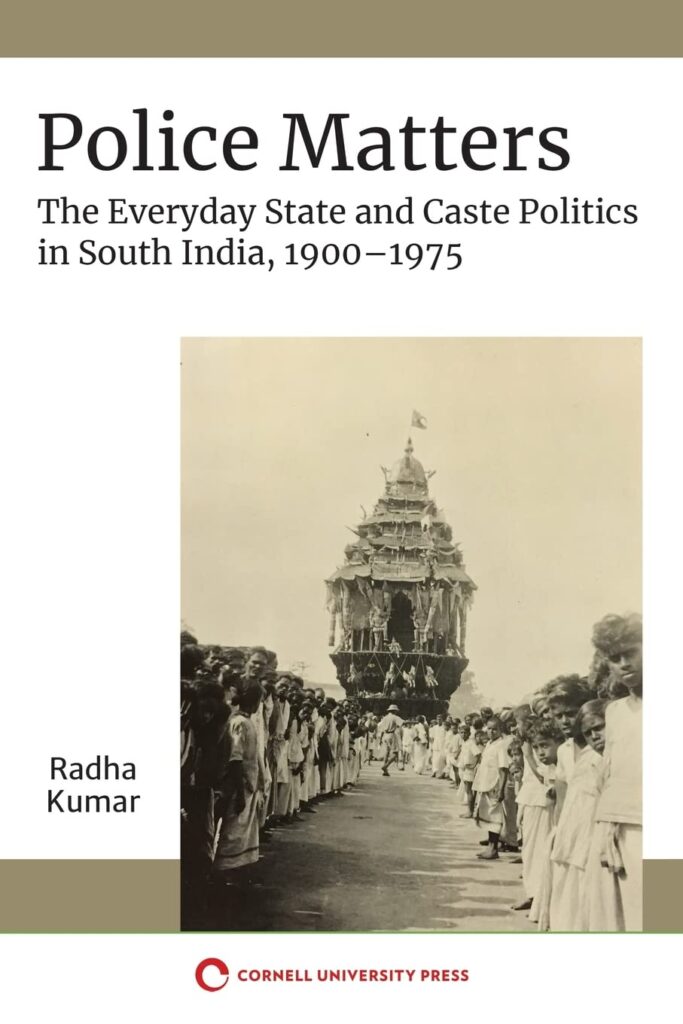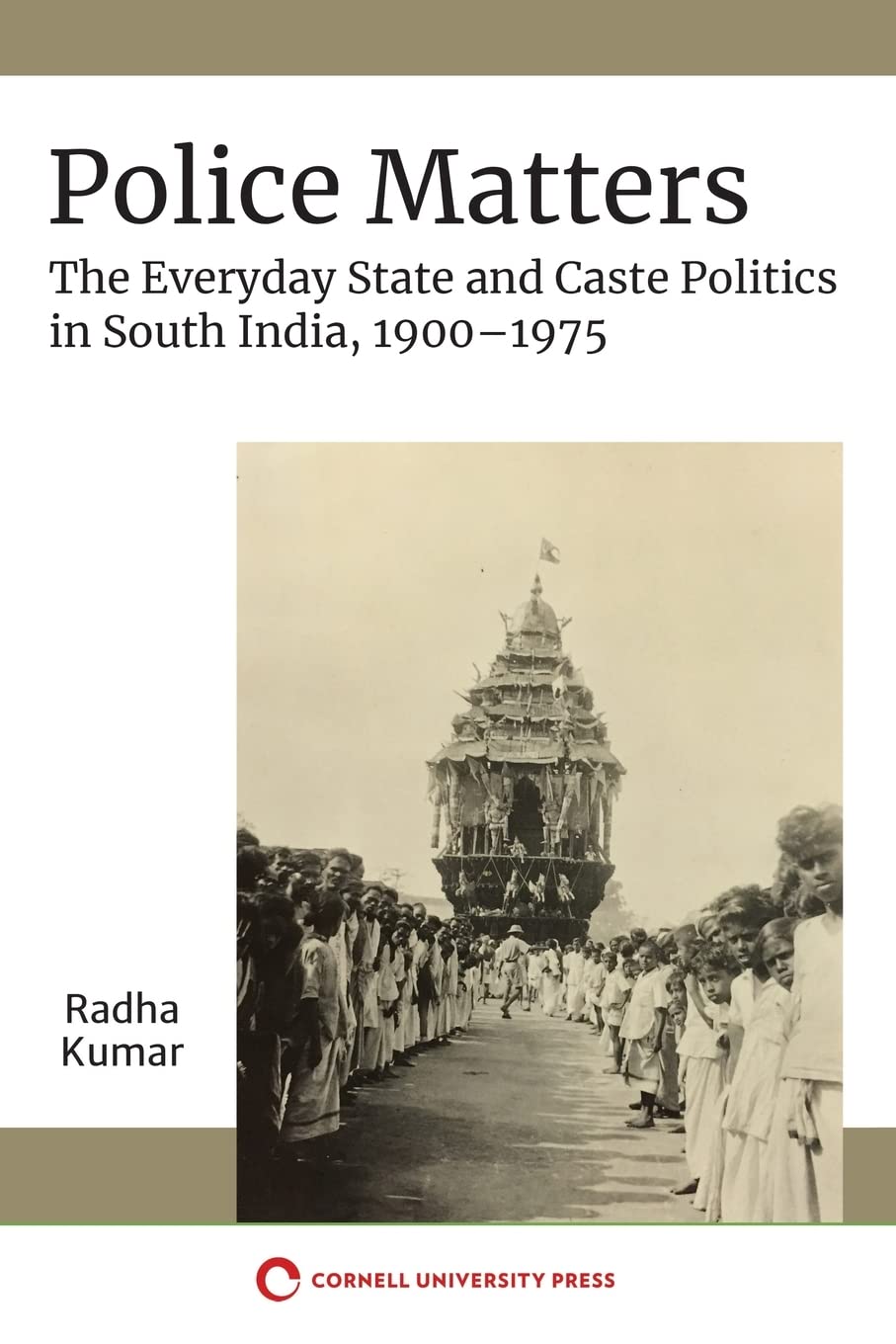
Reviewing Radha Kumar’s brilliantly written book Police Matters: The Everyday State and Caste Politics in South India, 1900-1975 (published by Cornell University Press in 2021) comes at an opportune time – in light of a Fourth Police Commission set up in Tamil Nadu this year. The struggle for caste identity has been long and bloody in the state and Radha Kumar’s book painstakingly illustrates how police surveillance did not just mirror social realities but how it also ultimately shaped them.
Radha Kumar expertly takes us through hitherto unexplored police archives of the erstwhile Madras Presidency and presently the state of Tamil Nadu – predominantly in Tamil-speaking districts of Madurai, Tirunelveli and Ramanathapuram. She navigates dusty police records, examines the origins of policing and tracks routine policing techniques from the arrangement of police stations, walking the beat, recording and investigating crimes and managing public assemblies, to reveal the intertwined world of policing and caste politics in the early twentieth century.
An interesting preface to the book is the analysis of how the police force came to be in colonial India. Pressures from the British government brought about the origins of the police force as an arm of the state in 1856, an organisational structure that was adopted by the Indian state through the Police Act of 1861 and remains largely unchanged since. The colonial government was not particularly interested in creating a modern and just police force. Economic and social transformations during the later half of the nineteenth century, for instance, the telegraph system and the railways, made the extraction of revenue easier for the colonial government and the police were established to safeguard the smooth flow of this extraction. In addition to this, it also brought a system of surveillance over the natives. She explains that the police was not an inaccessible entity but a constant presence in rural life.
Many of the economic and social transformations brought about by the colonial government meant economic and social progress for the nation but for the peasant and the tribal it meant facing the combined authority of the landlord, the money lender and an alien government. Radha Kumar argues that while the colonial government relied on the police for managing forests and securing properties; the police required extensive and continuous knowledge of the community. Police knowledge was produced during routine policing procedures which cemented stereotypes of caste and communities. Illustratively, the Chettiars and the Nadars, important trading communities, were provided special protection – extra beats and police stations – which in turn contributed to their economic success. On several occasions, they also sought out police protection against the theft of their properties. Conversely, communities like Koravars, Maravaras and the Kallars were seen as vagrant; communities that required constant monitoring. The police also drew from colonial knowledge of the community they were meant to serve and protect. Consequently, police production of knowledge and important policing decisions, from establishing police stations and beats, to the discretion on who to protect and who to monitor, relied on the knowledge of caste and in turn re-affirmed caste hierarchy and authority.
While the nature of policing was influenced and regulated by caste hierarchy, Kumar also notes that structurally, the police themselves were determined by the same hierarchy. Certain castes were more represented in the force than others as police recruitment drew on the same knowledge of caste hierarchy. Although this pattern of recruitment was discontinued in post-colonial India, some castes remained better represented than others. Caste hierarchy also determined the accessibility of the police to every community. Upper caste communities had the means to draw on police authority and sway this authority in their favour while the lower castes did not. Kumar argues that although police did not always re-affirm caste hierarchy, caste politics and policing were not independent of each other.
Kumar brilliantly portrays the nuances in policing techniques and ensuring caste authority, especially when describing the history behind the First Information Report. A simple document recording the commission of an offence was a pivotal document that could trigger an investigation. While the law required a policeman to register all cases, it provided him with the option to not investigate a case if he believed there were no sufficient grounds for an investigation – a “false case” in police statistics. The FIR then became a singular document that could decide whether a crime was committed; a document over which local power was negotiated. On one hand, communities with close ties to the police used this tool to record their version of events, while on the other hand, the police used their discretionary authority to determine which cases would be taken up for investigation.
Perhaps the most thought-provoking reflection that Kumar leaves me with at the end of this book is to recognise that the challenges the police faced in colonial India continue to be the challenges the force struggles with today. As Kumar writes about the structural organisation of the police, one cannot help but note that the standards used then are still in use today. For instance, a rural police station was to cover 150 sq. miles but in practice, its jurisdiction varied. According to the India Justice Report, 2019, urban populations enjoy notably superior police services than rural populations, as the average rural station served a much larger population than its urban counterpart.[i] The 1981 National Police Commission’s suggestion that the average area covered per rural police station should be 150 sq. km, remains the only available benchmark to date. Figures put into perspective that while the police may have been a constant presence in the rural countryside in the twentieth century, the citizenry had varying levels of access to state authority. This book juxtaposed with recent reports on policing proves that despite several recommendations for both immediate and long-term reform, the opportunity for the same has been squandered and deliberately overlooked over the years.
***
Nayanika Singhal is a researcher with the India Justice Report. Her research interests revolve around criminal justice system reform, particularly, police and prison reform. She is a graduate of Tata Institute of Social Sciences (TISS) Mumbai with a background in law.
[i] India Justice Report, 2020, p.32, available at: https://bit.ly/3nUOqHH
